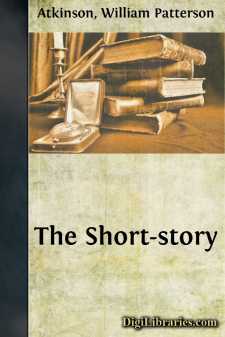Categories
- Antiques & Collectibles 13
- Architecture 36
- Art 48
- Bibles 22
- Biography & Autobiography 813
- Body, Mind & Spirit 142
- Business & Economics 28
- Children's Books 15
- Children's Fiction 12
- Computers 4
- Cooking 94
- Crafts & Hobbies 4
- Drama 346
- Education 46
- Family & Relationships 57
- Fiction 11828
- Games 19
- Gardening 17
- Health & Fitness 34
- History 1377
- House & Home 1
- Humor 147
- Juvenile Fiction 1873
- Juvenile Nonfiction 202
- Language Arts & Disciplines 88
- Law 16
- Literary Collections 686
- Literary Criticism 179
- Mathematics 13
- Medical 41
- Music 40
- Nature 179
- Non-Classifiable 1768
- Performing Arts 7
- Periodicals 1453
- Philosophy 64
- Photography 2
- Poetry 896
- Political Science 203
- Psychology 42
- Reference 154
- Religion 513
- Science 126
- Self-Help 84
- Social Science 81
- Sports & Recreation 34
- Study Aids 3
- Technology & Engineering 59
- Transportation 23
- Travel 463
- True Crime 29
The Short-story
Categories:
Description:
Excerpt
DEFINITION AND DEVELOPMENT
Mankind has always loved to tell stories and to listen to them. The most primitive and unlettered peoples and tribes have always shown and still show this universal characteristic. As far back as written records go we find stories; even before that time, they were handed down from remote generations by oral tradition. The wandering minstrel followed a very ancient profession. Before him was his prototype—the man with the gift of telling stories over the fire at night, perhaps at the mouth of a cave. The Greeks, who ever loved to hear some new thing, were merely typical of the ready listeners.
In the course of time the story passed through many forms and many phases—the myth, e.g. The Labors of Hercules; the legend, e.g. St. George and the Dragon; the fairy tale, e.g. Cinderella; the fable, e.g. The Fox and the Grapes; the allegory, e.g. Addison's The Vision of Mirza; the parable, e.g. The Prodigal Son. Sometimes it was merely to amuse, sometimes to instruct. With this process are intimately connected famous books, such as "The Gesta Romanorum" (which, by the way, has nothing to do with the Romans) and famous writers like Boccaccio.
Gradually there grew a body of rules and a technique, and men began to write about the way stories should be composed, as is seen in Aristotle's statement that a story should have a beginning, a middle, and an end. Definitions were made and the elements named. In the fullness of time story-telling became an art.
Similar stories are to be found in many different literatures because human nature is fundamentally the same the world over; that is, people are swayed by the same motives, such as love, hate, fear, and the like. Another reason for this similarity is the fact that nations borrowed stories from other nations, changing the names and circumstances. Writers of power took old and crude stories and made of them matchless tales which endure in their new form, e.g. Hawthorne's Rappaccini's Daughter. Finally the present day dawned and with it what we call the short-story.
The short-story—Prof. Brander Matthews has suggested the hyphen to differentiate it from the story which is merely short and to indicate that it is a new species—is a narrative which is short and has unity, compression, originality, and ingenuity, each in a high degree. The notion of shortness as used in this definition may be inexactly though easily grasped by considering the length of the average magazine story. Compression means that nothing must be included that can be left out. Clayton Hamilton expresses this idea by the convenient phrase "economy of means." By originality is meant something new in plot, point, outcome, or character. (See Introduction III for a discussion of these terms.) Ingenuity suggests cleverness in handling the theme. The short-story also is impressionistic because it leaves to the reader the reconstruction from hints of much of the setting and details.
Mr. Hamilton has also constructed another useful definition. He says: "The aim of a short-story is to produce a single narrative effect with the greatest economy of means that is consistent with the utmost emphasis."
However, years before, in 1842, in his celebrated review of Hawthorne's Tales Edgar Allan Poe had laid down the same theory, in which he emphasizes what he elsewhere calls, after Schlegel, the unity or totality of interest, i.e. unity of impression, effect, and economy. Stevenson, too, has written critically of the short-story, laying stress on this essential unity, pointing out how each effect leads to the next, and how the end is part of the beginning.
America may justly lay claim to this new species of short narrative. Beginning in the early part of the nineteenth century there had begun to appear in this country stories showing variations from the English type of story which "still bore upon it marks of its origin; it was either a hard, formal, didactic treatise, derived from the moral apologue or fable; or it was a sentimental love-tale derived from the artificial love-romance that followed the romance of chivalry." The first one to stand out prominently is Washington Irving's Rip Van Winkle, which was published in 1820....


